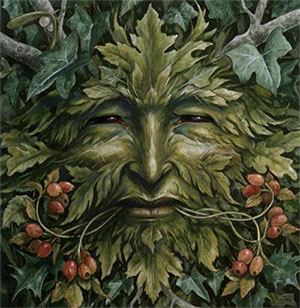Green Color Symbolism Facts & Meaning: Zodiac, Omens, Dreams, and Myths
I
Green Color Meaning
You can see the color green everywhere. It depicts the color of most plants, grass, trees, forests, or vegetables. It is the most common color of the natural environment. The green color primarily means nature, wealth, and safety.
As a color of nature, it signifies ecology, spring, balance, freshness, rebirth, and life. It is commonly used by organizations to display ecological and progressive advocacies. It also demonstrates that a company has concerns about the environment. In combination with the color red, it is widely associated with Christmas. The colors create a sense of vitality that compliments each other. As a color of wealth, it signifies money, finances, banking, prosperity, progress, ambition, and greed. It is also a good color indicator in the financial world to show growth and profitability. As a color of safety, it stands for permission and security to proceed as can be observed in traffic lights. It indicates a going ahead as expressed in the words “getting the green light” which means to take action. It is also commonly used to promote green products such as ecofriendly and sustainable goods and inventions. You can also see the color in the advertisements of medical products, drugs, natural and herbal supplements to indicate safety.
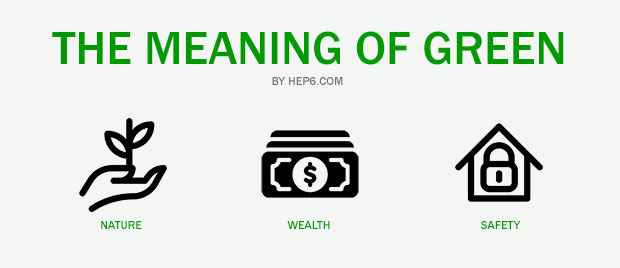
The color green has been observed as a color that can be trusted. Green conveys a quality that makes people feel more secure. Several businesses rely on the color green in their approaches to uphold healthy lifestyle and freshly safe products. This is often practiced in the food and healthcare industry.
The different shades of the color green mean differently. Dark green shade stands for ambition, wealth, and greed. Lime green means naivety and playfulness. Yellow green represents jealousy, cowardice, and sickness. Pale green indicates immaturity and inexperience. Olive green means peace but carry more popularly a strong association with camouflage and military. Jade green stands for diplomacy, trust, and confidentiality. Emerald green means inspiration and abundance.
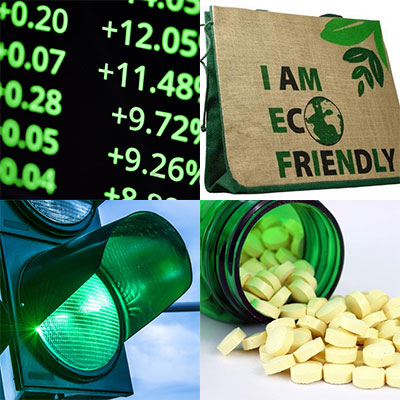
II
Green Color History
Considered to be the earliest evidence in the usage of the color green is the period of the Neolithic people of northern Europe. It may not be exactly the very first time of usage but a green dye was found in their clothing. It is a very low quality dye that appears more of the color brown than green. The dye was made out of birch tree leaves. Green dyes were often sourced from ferns, buckthorn berries, plantain, prior to the 16th century but the shade does not last long.
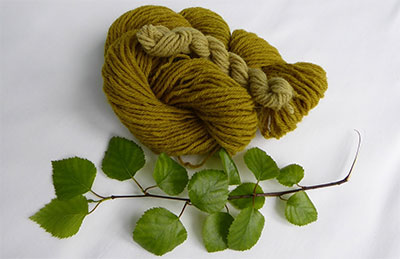
There are ancient Mesopotamian cave paintings that show people with green clothing. The pigment and dyes at that time is believed to be made from plants, fruits, and vegetables. Ancient Egyptian tomb walls and papyrus also showed the use of the color green. It is identified to be a green colored mineral called the Malachite which are mined. To dye their clothing green, a yellow dye made from saffron is primarily used, followed by soaking the clothing in a blue dye made of woad plant. Another way of producing the color green, they combine blue azurite and yellow ochre.
Ancient Romans made use of the green pigment on wall paintings in many of their cities. Unlike the Greeks, the Romans appreciate the color to have it used extensively. In the Renaissance period, the color of clothing is considered a social standing where green is seen as a low rank while red a position of nobility.
In the 18th century, synthetic pigments and dyes of the color green started to become available. It rapidly replaced the use of mineral and plants. It has also made to be a color popular in arts to depict emotions and not only nature. The dyes have also been more long lasting compared to the older methods. In many of the European countries during the 20th century, green is seen as a political symbol. Today the color green is widely a representation used for environmental movements.
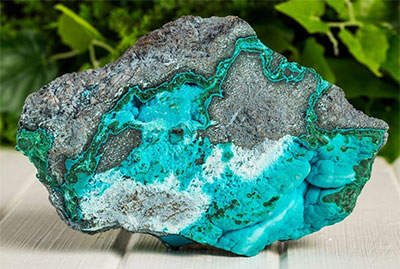
III
Green Color Symbolism
Green Color Positive Symbolism
There are a number of fascinating positive symbolism associated with the color green. Being the dominant color of nature, it symbolizes growth, tranquility, and healing.
Green as a symbol of growth is often used in design to foster productivity and creativity. In fact, the term “green light” is a common expression that indicates progress for tasks to be put into action. Green promotes freshness, optimism, and hopefulness. It strives to bring impact instead of staying worthless. It wants to create a positive outlook on life that many people are influenced by the color to become involved in the community.
The color green represents the natural world. It embodies lush greenery, vast landscapes, and rich foliage. It is the color of Mother Earth and regarded as the most relaxing and restful color for the human eye. As a symbol of tranquility, green exemplifies balance, vitality, peace, and harmony. This soothing color is said to promote enhancement of endurance and stability.
Believed as a color to help people concentrate, relax, and calm down, green is said to inspire a healing energy. It is a color that affects the mind and body providing relief from anxiety and nervousness. Green promotes optimal well-being that companies love using green when advertising their health products. This allows unaware consumers to feel safer and hopeful with the color because of a relation between wellness and the color green.
Green Color Negative Symbolism
While green is associated with health, it is also expressed to indicate sickness and nausea. This is often depicted in illustrations as a greenish tinge on the skin. Moreover, it is also related with poison and toxicity. The negative health connotation makes the color to feel distinctly unpleasant, yellow-gray greens in particular.
Green also stands for envy and jealousy. It is linked with selfish people. The color describes their negative characteristics of greed and possessiveness. The color can relate to a lack of passion and much impatience. This creates a sense of stagnation and isolation that is often associated with boredom. Green is also viewed to indicate lack of social interaction and interest.
Common as a color of growth, it indicates the need for renewal because green also symbolizes immaturity and a lack of experience. It advices coming back to life as natural as the spring season. It wants a rebirth fresh from the cold winter months. Green seeks to form new life and new growth. Without a balance of the color, it can be bad. Much of the color green signifies laziness, moodiness, lethargy, and slothfulness. Lack of the color green signifies fear of rejection and indifference.
IV
Green Color Physical and Psychological Effects
Green can have physical and psychological effects in several different ways. The color is a calming and relaxing shade. It is considered the most restful color to the human eye which helps enhance its stability, vision, and endurance. The color occupies more space in the visible spectrum and it is a shade that most people are used to see everywhere. The stress-relieving effects come with more relaxed muscles, pituitary gland stimulated, and histamine levels of the blood increased. With the dilation of the blood vessels, muscle contractions become smoother.
Another therapeutic effect includes experiencing lesser perceived exertion and lesser mood disturbance. It offers a therapeutic sense of security. In fact, it has shown to help people focus and reduce anxiety when placed to an area painted with the green color. The feeling of refuge experienced with the color can be associated with the relevance of green with nature where all the basic needs can be satisfied like water, food, and shelter. This can be helpful in achieving positive cognitive outcomes like optimism and improved memory. In effect, many indicators show that it makes remembering positive words written in green a lot easier.
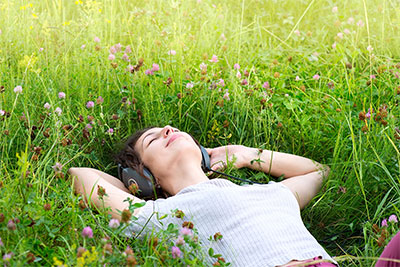
V
Green Favorite Color: Traits and Personality
Second to blue, the color green is one of the most commonly favored color. It says a lot about a person who has green as a favorite color. There are several character traits associated with people who love green including being smart, reliable, and independent. These are people who are visionaries, thinks strategically, and make decisions based on facts. They usually tend to love nature and believe in science, with a great hunger for learning.
As a nature lover, they can be modest, generous, and family-oriented. Relationships are grounded on respect and nurturing. Without a border to hide their ideas and emotions, they can make good friends and partners. Green lovers are practical, logical, and analytical. On the downside, there are some negative traits which include being stubborn and sometimes antisocial. People who love green also prefers to be in charge of living their lives on own terms. Still, they can be good at giving counsel to others because they find it easy to grasp ideas and understand problems with clarity.
VI
Green Color Cultural Symbolism
There can be different meanings of the color green from one culture compared to another. In reality, even each culture in Asia and Europe gives its own symbolism. Most parts of Asia find the color a positive symbol associated with life, sunrise, and growth. However, in China, the color green can mean unfaithfulness. Wearing a green hat expresses that a woman is cheating on her husband. During the Ming Dynasty, it was the color to symbolize the heavens. For people born on Wednesdays, green is a lucky color in Thailand. In Japan, it is nice to learn that the term for the color green and blue are the same.
Green is a holy color in Muslim countries. It has several traditional associations. Islamic religion believes that the color green is associated with paradise. It is also a color that can be seen on the flags of many Islamic countries. In fact, the banner of Prophet Muhammad is in color green.
The color had positive association in Egyptian culture. It is a symbol of agricultural wealth. Green signifies regeneration and rebirth. The color is also depicted as the green face of Osiris, the god of the underworld, to indicate good health.
The national color of Ireland is green. It is a color that symbolizes good luck, clovers, leprechauns, and Saint Patrick’s Day. It is also one of the three main colors you can see on their national flag. In ancient Rome, green was the color of the goddess Venus making it considerably of great value to them. Racy jokes are called “green” in Spain.
In the US, the color green is a representation of nature, health, spring, life, money, and envy. It also acts as a color of permission such as its use in green cards which allows people permanent residence in the country.
VII
Green Color Zodiac Sign
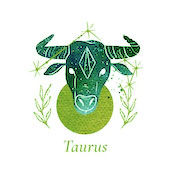
The green color is the zodiac color for Taurus, Virgo, and Pisces. It is identified with relaxation, growth, tranquility, and dependability.
Taurus is an earth sign which can have a deep connection with the color green. It is associated with the earth element and feminine energy. People born under Taurus tends to be grounded and trustworthy. The green color encourages a Taurus to tap into their distinctive attraction with prosperity and their ability of creating abundance. Just like the lush pastures where you can find the bulls, green cultivates Taurus’ spirit and strengthens its connection to nature and growth.
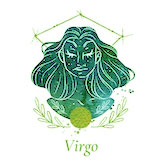
With strong ties to agriculture and new life, Virgo goes hand-in-hand with the power color green. It is also associated with the earth element and feminine energy. People born under Virgo tends to be perfectionist, practical, loyal friends, and focused on self-improvement. As a symbol of growth, the green color encourages a Virgo to strengthen lifelong plight toward self-improvement.
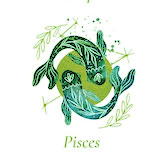
Pisces is the Latin word for “fishes”, which flourishes in the endowment of the seafoam green or aquamarine colors of water. It is associated with the water element and feminine energy. People born under Pisces tends to be creative, highly imaginative, emotional, and spiritual. The green color encourages a Pisces to be gentle and adaptable while embracing their mutable nature but steadfast with who they truly are.
VIII
Green Color Omens and Superstitions
The use of a green umbrella is said to indicate a protective union between all that is Mother Nature. To promote growth, optimism, hopefulness, balance, and break from emotional demands, the use of green gemstones is believed to be helpful.
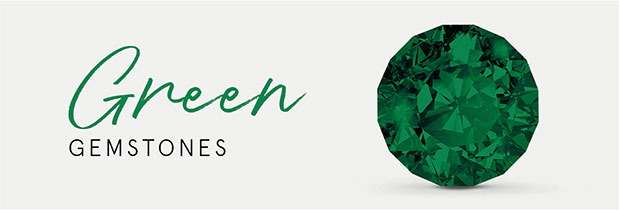
In Feng Shui, the color green is used to manage nervousness, absent-mindedness, and rudeness. Some beliefs tell that it is also the finest color for pregnant women. More interestingly, it has also been instructed by some that you can use a pea-green pillow to prevent baldness.
Green is widely considered a symbol of luck in many Western countries, more especially the green shamrock. However, it can also be an unlucky color to others. There are some that says wearing a green clothing in a funeral makes the person eventually wear black to a funeral of a relative. It is also a superstition that surrounds the death of a French actor and playwright who performed for King Louis the 14th using a green costume.
Even circus performers and traveling showmen avoid the color believing it is associated with death and accidents. It has also been an unpopular car color at racetracks saying it brings bad luck. Records of the superstition can be traced back in the 1700s when green is a color believed to bring death. At that time, arsenic was being used to create shades of green which was called Scheele’s Green. Arsenic being a highly toxic chemical element, many people became ill and some have died considering that it has been widely used in wallpapers and fabrics, releasing off a poisonous gas when become damp. In fact, analysis done on Napoleon Bonaparte’s lock of hair and wallpaper showed signs of arsenic which can demonstrate an argument on the rumors that he died of poisoning.
IX
Green Color in Dreams
Colors can have significant influence on human emotions. Dreaming of the color green can be associated with the attitude of the person to the particular color. In general, dreaming of the color green means desires to gain something or become independent. It can also mean desires of material things and money. It is important to understand the person in relation to the green object in the dream. The color green may signify peace and calm but can also be interpreted as envy, greed, and jealousy.
Green is a sign of something new and fresh. Dreaming of buying a green object means finding a new job or promotion at work. Dreaming of green leaves can mean revival and fulfillment of past longings whereas dreaming of wearing green clothing means new relationships. Dreaming of a green house or green fence indicates receiving something of large value.
A dream of lying on green grass means upcoming travel opportunities while dreaming of green fruits can mean your labor will bring good harvests.
X
Green Color Mythology and Folklore
Legend tells of Chinese green dragons who have been rulers of weather and water symbolizing power and strength. It is a symbol used by Chinese emperors to denote imperial supremacy. Until this day, Chinese festivals is popular with the display of the dragon as a vital part of the celebration.
In Celtic mythology, the fairy races that lived in the lands of the ancient Celtics favor the colors red and green. In order not to offend the fairy neighbors, the people avoid wearing the color. Scottish people even consider the color deadly to have a human make use of it. However, the fairies are believed to be an incarnation of the spirits of fertility and abundance that have provided for green flourishing vegetation.
A British folklore tells of the Green Man which is a figure that resembles the face of a man. These are mysterious beings peering out from leaves and branches. The face is described to sometimes have a compassionate look but some appears threatening or intoxicated. The creature is believed to represent a guardian spirit and masculine strength of abundance. Today, British festivals represent the Green Man with people wearing a leaf-covered mask or a costume of leaves dancing through the streets.
